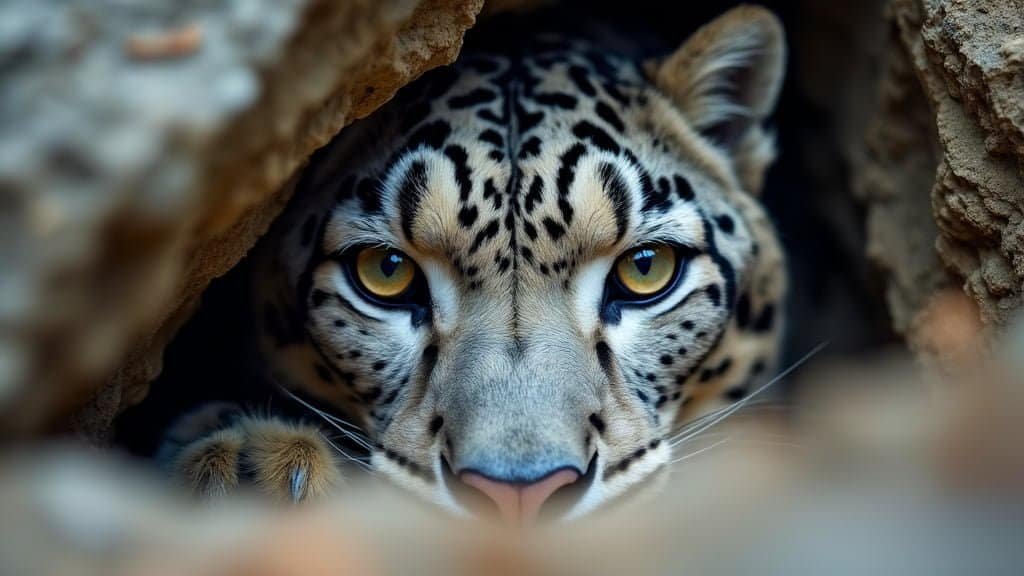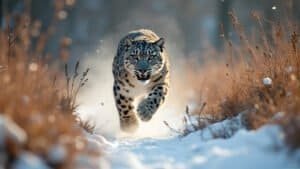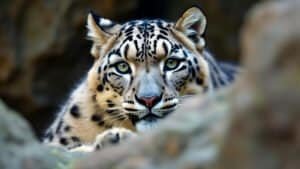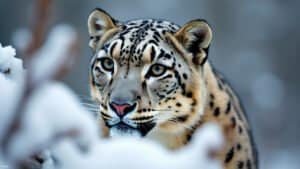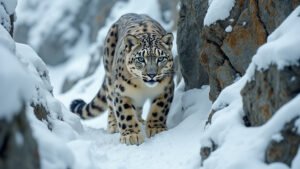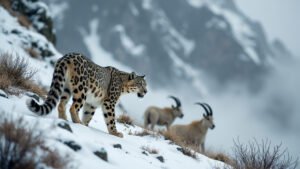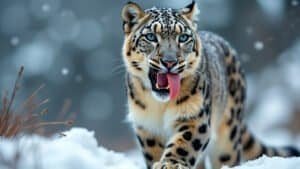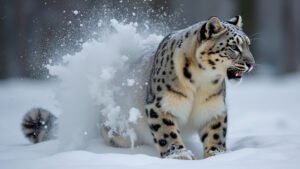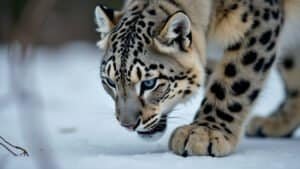Introduction
Snow leopards, known as elusive and powerful predators, are adept at hunting and handling large prey items in their harsh mountain habitats
This article will explore the various strategies snow leopards use to hunt and manage large prey, from their stalking and ambush techniques to the challenges they face in these endeavors
We will delve into their post-kill practices, such as transporting and protecting their kills, and examine the physical and behavioral adaptations that make them such effective hunters
Finally, we will consider the challenges snow leopards encounter when handling large prey, providing a comprehensive overview of their remarkable hunting prowess
Hunting Strategies for Large Prey
Snow leopards are remarkable predators, renowned for their ability to take down prey much larger than themselves, such as Himalayan blue sheep and ibex
Their hunting strategies are a combination of stealth, power, and intelligence, honed by thousands of years of evolution in some of the most rugged terrains on Earth
This section will explore how snow leopards stalk, ambush, and ultimately overpower large prey, highlighting the skills that make them apex predators in their environment
Stalking and Ambush Techniques
Snow leopards rely heavily on stealth to get within striking distance of their prey. Their natural camouflage, provided by their thick, spotted fur, allows them to blend seamlessly into the rocky and snowy landscapes of Central Asia
This camouflage is crucial, as the element of surprise is often the key to a successful hunt. The snow leopard’s approach is typically slow and deliberate, often taking advantage of the terrain to remain hidden. They use natural cover, such as rocks and ridges, to close the distance between themselves and their target without being detected
The snow leopard’s patience is legendary. They are known to stalk their prey for hours, waiting for the perfect moment to strike. This usually involves getting as close as possible before launching a sudden, powerful attack
The timing of the ambush is critical, as a missed opportunity can mean expending precious energy with no reward. Once they are within range, snow leopards leap at their prey with incredible speed, using their powerful hind legs to propel themselves forward
Power and Precision in the Kill
When it comes to delivering the fatal blow, snow leopards rely on their immense strength and precision. Their primary targets, such as blue sheep and ibex, are often large and sturdy animals that require a combination of force and technique to bring down
Snow leopards typically aim for the neck or throat, where a well-placed bite can sever vital arteries or crush the windpipe, leading to a swift kill
Their powerful jaw muscles and large canines are perfectly adapted for this task. According to studies, the bite force of a snow leopard is strong enough to penetrate thick hides and deliver lethal damage with remarkable efficiency. This is crucial in environments where energy conservation is vital, as prolonged struggles can be costly for both predator and prey
Additionally, snow leopards are known for their ability to adjust their tactics based on the size and behavior of their prey
For instance, when targeting larger animals, they may use their body weight to knock the prey off balance, especially in steep or uneven terrain. This not only incapacitates the prey but also helps the snow leopard avoid injury during the struggle
Patience and Planning in Difficult Terrain
The rugged, mountainous habitats of snow leopards present unique challenges that influence their hunting strategies. These environments are characterized by steep cliffs, rocky outcrops, and narrow valleys, which snow leopards navigate with extraordinary agility
Their large, muscular legs and padded paws provide stability and traction on uneven surfaces, allowing them to pursue prey across treacherous landscapes
Snow leopards use the terrain to their advantage, often driving prey into areas where escape routes are limited. For example, they may chase animals toward cliffs or other obstacles, where the prey’s options for escape are severely restricted. This tactic increases the chances of a successful kill, as the prey has fewer opportunities to flee
In addition to their physical prowess, snow leopards exhibit remarkable cognitive abilities in planning their hunts. They are known to study their environment and the behavior of their prey, choosing the optimal time and place for an ambush
This level of strategic thinking is crucial in environments where food is scarce, and a failed hunt can have serious consequences
Snow leopards also exhibit adaptability in their hunting techniques, altering their approach based on the season and availability of prey. During the winter, when snow covers the ground, they may use the cover of snowfall to approach prey more closely. In contrast, in the summer months, when prey is more dispersed, they may rely more on endurance and persistence to secure a meal
The combination of stealth, power, and adaptability makes snow leopards highly efficient hunters, capable of taking down prey that is often larger and stronger than themselves
Their success is a testament to the specialized skills and strategies they have developed over millennia, allowing them to thrive in some of the harshest environments on Earth
Post-Kill Management
After successfully bringing down a large prey item, a snow leopard’s work is far from over. The predator must now manage its kill in ways that maximize nutritional gain while minimizing the risks of losing it to scavengers or other predators
This involves transporting the prey, protecting it from competitors, and consuming it efficiently over time. Each of these tasks requires a different set of strategies, which are crucial for the survival of this solitary and resourceful cat
Transporting Large Prey
One of the most impressive feats of the snow leopard is its ability to transport large prey items across challenging terrains. After a successful kill, a snow leopard will often drag its prey to a safer location, typically uphill and away from the kill site
This effort is intended to reduce the likelihood of the kill being discovered by scavengers, such as vultures, ravens, and other carnivores like wolves or even bears
The snow leopard’s powerful limbs and muscular build are key to this task. Despite their relatively modest size compared to other big cats, snow leopards can move prey that weighs as much as 75% of their own body weight
This ability to relocate a kill is particularly important in their mountainous habitats, where scavengers are plentiful and a snow leopard might need to move its meal a considerable distance to avoid competition
Moreover, snow leopards often utilize the natural features of their environment to aid in transporting prey. For example, they may drag the carcass into a crevice or a dense thicket where it is less likely to be detected
This behavior not only ensures that the snow leopard can feed in relative peace but also helps to conserve the energy that would otherwise be spent defending the kill
Protecting the Kill from Scavengers
Even after successfully moving the prey, snow leopards face the constant threat of scavengers. To mitigate this risk, they must remain vigilant and employ various strategies to protect their kill
Snow leopards are known for their cautious nature, often returning to their kill site at irregular intervals to avoid detection by other predators
One of the primary methods snow leopards use to protect their kill is to stay close by, often resting nearby in a concealed location
This proximity allows them to defend the prey from opportunistic animals, particularly during the critical first hours after the kill when the scent of blood is most likely to attract attention. They may also cover the kill with dirt, snow, or debris to mask its scent and further deter scavengers
Additionally, snow leopards are known to eat quickly after making a kill, consuming as much meat as possible in a short period. This behavior reduces the amount of time the carcass is left exposed, decreasing the chances of it being stolen
However, they are also strategic in leaving parts of the kill behind that are less desirable to scavengers, such as bones or skin, which can slow down potential competitors and give the snow leopard more time to return for additional feedings
Efficient Consumption Over Time
Snow leopards are solitary animals and do not need to share their kills with others, unlike some big cats that live in prides or groups. This solitary nature allows them to consume their prey over several days, making large kills particularly valuable
They typically start with the most nutritious and easily accessible parts of the prey, such as the internal organs and the muscle tissue, which provide the highest energy returns
Given the energy demands of living in high-altitude, cold environments, snow leopards must be efficient in how they consume their prey. They may feed for several hours immediately after a kill and then return to the carcass over the following days, depending on the size of the prey and the level of threat from scavengers
This prolonged feeding strategy ensures that they extract the maximum nutritional value from each kill, which is critical in environments where food sources can be scarce
Snow leopards also exhibit behavior that suggests they plan their consumption based on environmental conditions. For example, they are known to cache parts of their kill, hiding them under rocks or in crevices to return later
This behavior is particularly useful in times when hunting is difficult, such as during harsh winter conditions when prey may be more dispersed or difficult to catch
This strategic approach to managing their kills highlights the snow leopard’s remarkable adaptability and intelligence. Their ability to secure and consume large prey efficiently is vital for their survival in the demanding landscapes they call home
By effectively managing their food resources, snow leopards ensure that they can sustain themselves and maintain their strength for the next hunt
Adaptations That Aid in Handling Large Prey
Snow leopards have evolved a range of physical and behavioral adaptations that enable them to handle large prey successfully. These adaptations are essential for their survival in the harsh, mountainous environments where they live
From their powerful physique to their unique hunting techniques, snow leopards are superbly equipped to take down and manage prey that is often much larger than themselves
This section will explore these adaptations, focusing on their strength, camouflage, and behavioral traits that contribute to their prowess as hunters
Physical Strength and Endurance
The physical strength of snow leopards is one of their most crucial adaptations for handling large prey. Despite being one of the smaller big cats, snow leopards are incredibly strong relative to their size
Adult snow leopards typically weigh between 60 to 120 pounds, yet they can bring down prey that is two to three times their own weight, such as the blue sheep and ibex
This impressive strength is largely due to their powerful hind legs, which are longer and more muscular than those of other big cats. These legs not only enable them to leap great distances but also provide the force necessary to overpower large animals
Their paws are large and cushioned, helping them maintain grip and balance on rocky and uneven surfaces, which is essential when wrestling with large, struggling prey
Additionally, snow leopards possess a robust musculoskeletal system, with a particularly strong neck and shoulder muscles that aid in delivering the killing bite. Their long, thick tails also play a critical role, providing balance during their high-speed chases and serving as a counterweight when dragging heavy prey uphill
Camouflage and Stealth
Camouflage is another vital adaptation that aids snow leopards in hunting large prey. Their thick fur, patterned with rosettes and spots, is perfectly suited to their natural environment, blending seamlessly with the rocky, snowy landscapes of Central Asia
This camouflage is essential for both stalking prey and avoiding detection by potential competitors and larger predators
Snow leopards’ ability to move silently through their environment further enhances their stealth. Their padded paws allow them to tread softly, reducing noise and vibration that might alert prey to their presence
This stealth is critical in the final stages of a hunt, where getting close enough to launch a surprise attack can mean the difference between success and failure
Moreover, snow leopards are primarily crepuscular, meaning they are most active during the dawn and dusk. These low-light periods provide additional cover, making it easier for them to approach their prey undetected
Their keen eyesight, adapted to see well in dim light, allows them to spot prey from long distances, giving them a significant advantage in these twilight hours
Behavioral Adaptations in Harsh Environments
Beyond their physical traits, snow leopards have developed a range of behavioral adaptations that help them manage large prey in their challenging environments. One such adaptation is their solitary nature
Unlike lions, which hunt in prides, snow leopards are solitary hunters, relying entirely on their own skills and strength to bring down large prey. This solitary lifestyle necessitates a high level of efficiency in hunting and managing prey, as there is no support from others to defend or consume the kill
Snow leopards are also highly territorial, with home ranges that can cover hundreds of square miles. This territorial behavior ensures that they have exclusive access to prey within their range, reducing competition from other snow leopards
They mark their territories with scent markings, such as urine or claw marks on rocks, to deter intruders and maintain control over their hunting grounds
In addition to their territoriality, snow leopards are opportunistic hunters, capable of adapting their hunting strategies to the availability of prey
During periods of scarcity, they are known to hunt smaller animals, such as marmots or hares, to sustain themselves. This adaptability is crucial in the unpredictable and often harsh climates they inhabit, where large prey may not always be available
Another key behavioral adaptation is their ability to endure long periods without food. Snow leopards have slow metabolisms compared to other big cats, which allows them to survive on fewer calories
This adaptation is particularly important in winter when food is scarce, and energy conservation becomes critical. When they do make a large kill, they can consume up to 20 pounds of meat in one feeding, storing the energy for future use
These physical and behavioral adaptations combine to make snow leopards highly effective at handling large prey
Their strength, stealth, and strategic behaviors are all finely tuned to the demands of their environment, allowing them to thrive as apex predators in some of the most extreme landscapes on Earth
Challenges Snow Leopards Face with Large Prey
While snow leopards are highly skilled predators, capable of handling large prey, they face significant challenges in doing so. These challenges stem from both their physical environment and the inherent risks of hunting large animals
From the potential for injury during hunts to the impact of environmental factors and competition from other predators, snow leopards must overcome numerous obstacles to successfully hunt and consume large prey
This section will explore the various challenges that snow leopards encounter and how these difficulties affect their survival
Risk of Injury During Hunts
Hunting large prey is inherently dangerous for snow leopards. Their targets, such as ibex and blue sheep, are powerful animals with sharp hooves and horns that can inflict serious injuries
The rugged terrain in which snow leopards hunt adds to the risk, as steep cliffs and rocky surfaces increase the likelihood of falls or missteps during a chase
Injuries sustained during hunts can be life-threatening for snow leopards, especially given their solitary nature. Unlike social predators, such as lions, which can rely on group members to bring down prey or share kills, snow leopards must hunt alone
An injury can therefore result in an extended period of time without food, as the leopard may be unable to hunt effectively or defend its kill from scavengers. This makes every hunt a high-stakes endeavor, where the snow leopard must balance the need to secure food with the risks of engaging large, dangerous prey
Studies have shown that injuries are not uncommon among snow leopards. A research paper published in the Journal of Mammalogy noted that injuries such as broken teeth, fractured limbs, and even wounds from prey are often observed in wild snow leopards
These injuries highlight the perilous nature of their hunting lifestyle and underscore the physical toll that hunting large prey can take on these solitary cats
Environmental and Seasonal Factors
The harsh environments in which snow leopards live also present significant challenges to hunting large prey. Snow leopards inhabit some of the most rugged and remote regions of Central Asia, including the Himalayas, the Tian Shan, and the Altai Mountains
These areas are characterized by extreme weather conditions, including heavy snowfall, bitterly cold temperatures, and high winds, all of which can complicate hunting efforts
During the winter months, snow can cover vast expanses of the leopard’s territory, making it difficult to track prey and move quickly through the landscape. Prey animals may also be more dispersed during this time, seeking lower elevations or areas with less snow cover, which can increase the energy costs of hunting
Additionally, avalanches and rockslides are a constant hazard in these mountainous regions, posing a danger not only to the prey but also to the snow leopards themselves
Seasonal variations in prey availability further challenge snow leopards. In the summer, when prey animals such as blue sheep and ibex move to higher elevations to graze, snow leopards must follow them, often traversing difficult and exposed terrain
This seasonal migration requires a significant expenditure of energy and increases the risks associated with hunting in unfamiliar or treacherous areas
Competition and Predation Risks
Snow leopards, despite being apex predators, are not immune to competition and predation risks. In many parts of their range, snow leopards share their habitat with other large predators, such as wolves and brown bears, which can pose a threat to their kills
These predators are often larger and may operate in packs or groups, giving them an advantage in overpowering a solitary snow leopard
Wolves, in particular, can be a significant threat to snow leopards. They are known to scavenge from snow leopard kills and, in some cases, may even attempt to take down the leopard itself if they are in a large enough group
Brown bears are another competitor, especially during the summer months when they are active and more likely to encounter snow leopard kills. The presence of these competitors forces snow leopards to be constantly vigilant and often necessitates moving their kills to more secure locations, which can be energy-intensive and risky
Additionally, snow leopards must contend with the threat of predation on their young. Cubs are particularly vulnerable to attacks from other predators, and snow leopard mothers must be exceptionally cautious in where they choose to den and how they protect their young
The loss of cubs to predation can have a significant impact on snow leopard populations, as these big cats typically have small litter sizes and extended periods of parental care
Conclusion
Snow leopards are extraordinary predators, uniquely adapted to the challenging environments of Central Asia’s mountainous regions. Their ability to handle large prey stems from a combination of physical strength, stealth, and strategic intelligence
From the initial hunt, where they use their powerful legs and camouflage to stalk and ambush prey, to the post-kill management of transporting and protecting their meal, snow leopards demonstrate remarkable skill and adaptability
However, their success does not come without challenges. The risk of injury, environmental hardships, and competition from other predators are constant obstacles these solitary cats must overcome. Despite these challenges, snow leopards continue to thrive, thanks to their incredible resilience and the finely tuned adaptations that have allowed them to survive in some of the world’s harshest terrains
